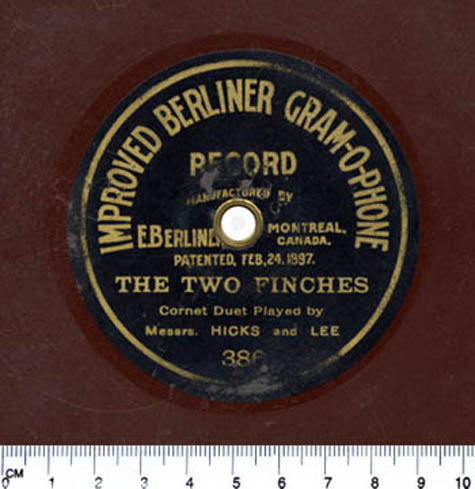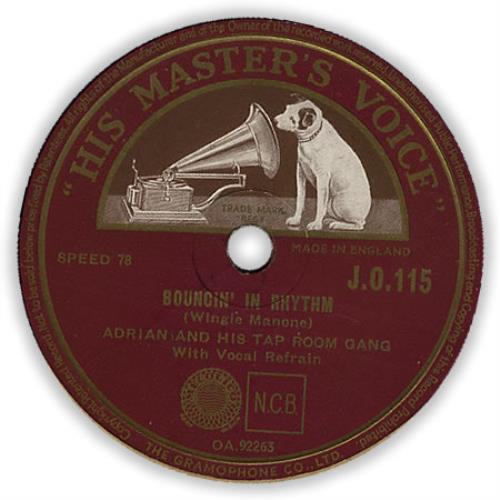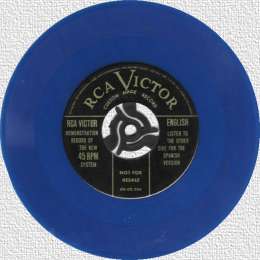Record Collecting: Everything You Wanted To Know But Were Afraid To Ask….Part 9: How Was Vinyl Invented?
Just recently you can’t seem to move for stories of vinyl’s resurgence, think fancy looking graphs with sales of vinyl pointing up, up, up, pictures of hipsters clutching LPs, men with beards rifling through the racks of a good ol’ fashioned record shop etc etc. With this in mind we thought we’d give you a little bluffers guide as to how the vinyl format came to be……
 n 1888 a gentlemen named Emile Berliner invented the flat disc record. These very first discs were produced of a vulcanised rubber and were between 12.5cm and 18cm in diameter.
n 1888 a gentlemen named Emile Berliner invented the flat disc record. These very first discs were produced of a vulcanised rubber and were between 12.5cm and 18cm in diameter.

Emile Berliner

An example of an E. Berliner, Montreal brown disc
Later he discovered that a mixture of shellac (a secretion from the lac beetle) and slate dust produced an extremely hard wearing but very brittle surface and from this the 78rpm disc was developed. The slate dust was used because the older acoustic gramophones used steel needles with a pick-up weight of up to 200 grams and the slate helped grind the needle to fit the groove more closely. A modern record pick-up tracks at a recommended maximum of 7 grams. Most record players today can pick up a track at under 1 gram.
 etween 1900 and 1960 the discs were usually 25 or 30cm across & gave between 2 and 5 minutes playing time each side. In the beginning sound was recorded with a horn attached to a diaphragm and stylus, which scratched out a trace in a rotating wax disc. This method lasted until 1925, when microphones became sufficiently developed to allow the recording of music.
etween 1900 and 1960 the discs were usually 25 or 30cm across & gave between 2 and 5 minutes playing time each side. In the beginning sound was recorded with a horn attached to a diaphragm and stylus, which scratched out a trace in a rotating wax disc. This method lasted until 1925, when microphones became sufficiently developed to allow the recording of music.

An early shellac 78 that we currently have in stock, this is by Adrian & His Tap Room Gang and was released in 1935! More info here
 uring the Second World War records were sent from the USA to overseas POW camps to keep up prisoner morale. Due to their brittleness these were frequently broken in transit, so a new compound, vinyl, was born to give greater flexibility and reduce the likelihood of breakages. During the war years vinyl was a very expensive material but the special circumstances of war justified it’s use.
uring the Second World War records were sent from the USA to overseas POW camps to keep up prisoner morale. Due to their brittleness these were frequently broken in transit, so a new compound, vinyl, was born to give greater flexibility and reduce the likelihood of breakages. During the war years vinyl was a very expensive material but the special circumstances of war justified it’s use.
 y 1948, Columbia Records had developed its 30cm Long Playing record, rotating at 33rpm and giving about 20-30 minutes a side which saw the downfall of shellac and vinyl was used from then on. Long-playing phonograph records may look the same now as when they were introduced in 1948, but countless refinements and developments within the industry have been made to perfect the long-playing record’s technical excellence and insure the best in sound reproduction and quality available in recorded form.
y 1948, Columbia Records had developed its 30cm Long Playing record, rotating at 33rpm and giving about 20-30 minutes a side which saw the downfall of shellac and vinyl was used from then on. Long-playing phonograph records may look the same now as when they were introduced in 1948, but countless refinements and developments within the industry have been made to perfect the long-playing record’s technical excellence and insure the best in sound reproduction and quality available in recorded form.

Great 1948 Columbia advert introducing ‘the long playing micro groove record’…..
 year later the first 45rpm disc was produced by RCA, 18cm in diameter and giving about 3 minutes a side. No better than the 78 for playing time, but ideal for pop record companies and juke box manufacturers! The 45 was light, compact, sounded much better than the 78 and was less prone to getting broken. 1958 saw the arrival of stereo records although unsuccesful experiments with two channel sound had been going on since before the First World War. This pleased those first “collectors” but irritated the retailers who had to keep dual stocks of LPs in mono and stereo and of course, the record companies had to prepare separate mono and stereo mixed versions of the LPs to start with. Stereo was generally only used for LPs up until about 1970, when pop singles began to appear in stereo versions so by this time the mono LP became a thing of the past.
year later the first 45rpm disc was produced by RCA, 18cm in diameter and giving about 3 minutes a side. No better than the 78 for playing time, but ideal for pop record companies and juke box manufacturers! The 45 was light, compact, sounded much better than the 78 and was less prone to getting broken. 1958 saw the arrival of stereo records although unsuccesful experiments with two channel sound had been going on since before the First World War. This pleased those first “collectors” but irritated the retailers who had to keep dual stocks of LPs in mono and stereo and of course, the record companies had to prepare separate mono and stereo mixed versions of the LPs to start with. Stereo was generally only used for LPs up until about 1970, when pop singles began to appear in stereo versions so by this time the mono LP became a thing of the past.

Here is what RCA Victor’s original 45 looked like. Note the large centre hole which needs an adaptor to make it fit a regular UK style spindle. Also note that coloured vinyl was not such a novelty in the 1940s! This image and text is from 45-rpm.org.co.uk
 n the late 1950s some companies experimented with a 16rpm speed originally intended for ‘talking books’ but was also used for music LPs in Eastern Europe and Africa. An American company also produced an 8rpm discs in the early 1970s for talking books for the blind. The 12″ single made it’s first appearance in 1975 and was only ‘discovered’ by mistake, top disco remixer Tom Moulton would regularly make 7″ test pressings of mixes he was working on, these would be supplied to the top DJ’s of the era in order to gauge how they worked on the dancefloor. However, one fateful night the studio was out of 7″ acetates and so he used a 12″ acetate, the response he got from the DJ’s was incredible, all reported a much better sound quality and overall volume. The 12″ single also makes the most of the best features of the 33 and 45rpm formats by offering a reasonable playing time (up to 12 mins/side) at a greatly enhanced volume and frequency response. EMI produceed a short run of classical LPs on this format in the early 1980s.
n the late 1950s some companies experimented with a 16rpm speed originally intended for ‘talking books’ but was also used for music LPs in Eastern Europe and Africa. An American company also produced an 8rpm discs in the early 1970s for talking books for the blind. The 12″ single made it’s first appearance in 1975 and was only ‘discovered’ by mistake, top disco remixer Tom Moulton would regularly make 7″ test pressings of mixes he was working on, these would be supplied to the top DJ’s of the era in order to gauge how they worked on the dancefloor. However, one fateful night the studio was out of 7″ acetates and so he used a 12″ acetate, the response he got from the DJ’s was incredible, all reported a much better sound quality and overall volume. The 12″ single also makes the most of the best features of the 33 and 45rpm formats by offering a reasonable playing time (up to 12 mins/side) at a greatly enhanced volume and frequency response. EMI produceed a short run of classical LPs on this format in the early 1980s.

Walter Gibbons stunning 9 minutes overhaul of Double Exposures ‘Ten Per Cent’ was one of the very first commercially available 12″ singles
 espite the devastation caused to vinyl sales by the rapid rise in popularity of the CD, the format in recent years has undergone a complete renaissance with untold stories in the press and media about the growth in vinyl sales. Indeed if proof were needed consider supermarket giant Tesco’s recent announcment that they are to stock a ‘Top 20 Vinyl’ section in their supermarkets, you have to admit it’s an unlikely outcome for a format that to all intents and purposes was ‘dead’ ten years ago – Long may it continue that’s what we say!
espite the devastation caused to vinyl sales by the rapid rise in popularity of the CD, the format in recent years has undergone a complete renaissance with untold stories in the press and media about the growth in vinyl sales. Indeed if proof were needed consider supermarket giant Tesco’s recent announcment that they are to stock a ‘Top 20 Vinyl’ section in their supermarkets, you have to admit it’s an unlikely outcome for a format that to all intents and purposes was ‘dead’ ten years ago – Long may it continue that’s what we say!
If all that’s got you in a vinyl mood, why not check eil.com for a huge range of rare vinyl, reissues, new releases, imports and more, to see the full list please click here